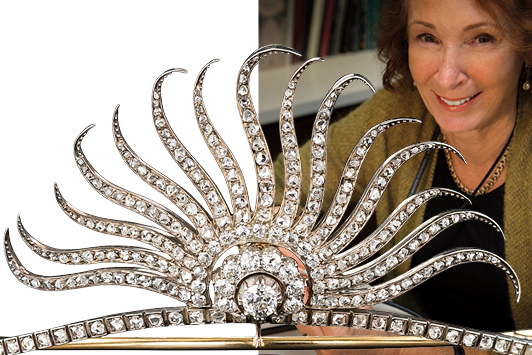 Image: Cole Bybee/LangAntiques.com
What are the most popular bejeweled accessories?
Image: Cole Bybee/LangAntiques.com
What are the most popular bejeweled accessories?
We consider accessories to be wearable as well as small objets d’art, decorative objects that have form and function. In the wearable category, the most popular items right now are hair ornaments. Tiaras have had a lot of attention over the past 10 years. Unfortunately, they are not readily available and not within most consumers’ budgets. I see that Hancock’s of London rents them! Tiara/crown-like pins come in many sizes and can be worn in the hair with a stunning effect. We have supplied stylists with star pins to be worn as a group in the hair as well. To facilitate the wearing of pins in the hair, we regularly convert them with barrette findings.
Dress sets, cuff links and stud buttons were very popular in the early 20th century through the 1930s. They were more conservative, being confined to the shape of a button, but incorporated gems and diamonds to great effect.
In the collector category, we have always found boxes to have an appeal. They are small works of art. Some are enameled, engraved or gem-set. Each is unique. My favorites are the enameled Art Deco vanity cases and nécessaires.
Which eras produced the most collectible items?
The late 19th to the early 20th centuries produced some of the most collectible items. The old and new wealthy of the day had a voracious appetite for adorning themselves and their homes with objects of refined beauty and value. Jewelry houses were purveyors, designers and makers of decorative art objects of all kinds. Most functional items were also made for the elite consumer as objects of art; if it could be embellished, it was. As an aside, the European upper class and royalty would have sumptuous affairs and give out Fabergé objets as party favors.
In addition to tiaras and boxes, [there were] cigarette and cigar boxes, smoking accessories, scent bottles, clocks, lorgnettes, parasol handles, walking-stick handles, gem-set handbags, hair combs, and vanity sets, as well as lamps, glassware and fine silverwork.... The materials included precious metals, ivory, gemstone carvings, ancient objects, glass, and tortoiseshell, to name a few. Think Fabergé eggs, Tiffany Favrile glass, Lalique plique-à-jour, and Cartier clocks. Of course, all fine-jewelry houses were also producing fine collectible objets.
How available are these objects in today’s market?
Museum-quality collectibles are not readily available, and when they are, they’re usually seen at auction, to much fanfare and high hammer prices. Private collections are sometimes sold discreetly as well. There is not one category that is most available. We find pieces one at a time when the opportunity presents itself. We used to see a lot more fine objets 25 years ago. However, there are still treasures to be found in private hands. We bought a large collection of fine jewelry a couple of years ago that included some very fine boxes. They had been in the family for over 100 years.
What are your criteria for deciding which items to stock?
Good design is good design. Beyond that, there is quality of manufacture. The quality of design and execution in a Fabergé piece [is recognizable,] but there are many unsigned pieces that are equally well made. Condition is always important; however, we are more lenient with special pieces, as there most likely is only one. Identifying the maker is always an added value.
Article from the Rapaport Magazine - April 2022. To subscribe click here.